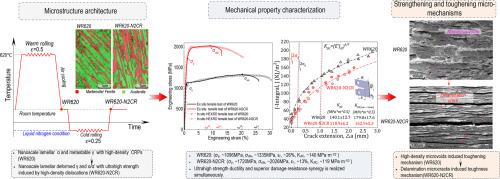Activating synergistic strengthening-toughening mechanisms by tailoring complex lamellar microstructure in a 2 GPa low-carbon alloy TRIP steel
IF 14.3
1区 材料科学
Q1 MATERIALS SCIENCE, MULTIDISCIPLINARY
引用次数: 0
Abstract
Breaking through the strength-toughness (ductility) tradeoff of ultrastrong steels has been an enduring pursuit in the scientific community. In the present work, superior synergistic combinations of ultrahigh strength (ultimate tensile strength, ∼2026 Mpa), desirable ductility (total elongation, ∼13%), and exceptional fracture toughness (KJIC, ∼119 Mpa m−1/2) were achieved in a low-carbon alloy transformed-induced plasticity (TRIP) steel by microstructural architecture, specifically, by utilizing multi-delamination crack toughening evolved from microvoids induced toughening and deformation-induced martensitic transformation (DIMT) toughening strategy. Firstly, nanoscale lamellar ferrite (α) and metastable austenite (γ) strengthened by high-density Cu-rich precipitations were obtained by warm rolling (WR). Fabricated numerous lamellar interfaces and surrounding ductile α and γ phases in the WR620 steel trigger a microvoids-induced toughening mechanism that is characterized by high-density non-aggregated microvoids (∼2.5 × 104 mm−2), resulting in superior crack-initiation and crack-growth toughness. Secondly, maintaining these microstructure characteristics, further strengthening of constituent phases was achieved by cold rolling deformation at cryogenic temperature, which implants preferentially high-density dislocations in γ and ensures ultrahigh mechanical stability regarding DIMT in WR620-N2CR steel. Combined with ultrastrong α/α’, optimized TRIP-assisted lamellar microstructure conquers the dilemma of strength-ductility tradeoff at ultrahigh yield strengths, meanwhile, without significantly deteriorating fracture toughness. These fabricated lamellar interfaces serve as preferential sites for the initiation of delamination microcracks, resulting in excellent crack-initiation fracture toughness. Nanoscale lamellar constituent phases with ultrahigh strength and deformed γ with ultrahigh critical martensitic transformation stress further retard catastrophic propagation and coalescence of delamination microcracks, which demonstrates a multi-delamination crack toughening mechanism from the perspective of observed fractographic features and derived micro-mechanically ductile fracture model. Additionally, the in-situ DIMT toughening enhances fracture toughness by simultaneously absorbing energy, which determined contribution accounts for 28.0% and 21.3% of the total fracture toughness in WR620 and WR620-N2CR steels, respectively. To summarize, our findings provide a microstructural architecture strategy and reveal synergistic strengthening-toughening mechanisms to design steel with ultrahigh strength-ductility and superior damage-resistance synergy.

通过调整2gpa低碳合金TRIP钢的复杂层状组织,激活增强韧化机制
突破超强钢的强度-韧性(延展性)平衡一直是科学界长期追求的目标。在本研究中,通过显微组织结构,在低碳合金相变诱导塑性(TRIP)钢中实现了超高强度(极限抗拉强度,~ 2026 Mpa)、理想的延展性(总伸长率,~ 13%)和优异的断裂韧性(KJIC, ~ 119 Mpa m−1/2)的协同组合,具体来说,采用由微孔诱导增韧和变形诱发马氏体相变(DIMT)演变而来的多层裂纹增韧策略。首先,通过温轧(WR)得到了高密度富cu沉淀强化的纳米级片层铁素体(α)和亚稳奥氏体(γ)。在WR620钢中制备了大量的片层界面和周围的延展性α和γ相,引发了高密度非聚集微孔(~ 2.5 × 104 mm−2)的微孔诱导增韧机制,从而产生了优异的裂纹萌生和裂纹扩展韧性。其次,在保持这些组织特征的同时,通过低温冷轧变形进一步强化组织相,这优先植入了高密度γ位错,并确保了WR620-N2CR钢中DIMT的超高机械稳定性。与超强α/α′相结合,优化的trip辅助层状组织克服了超高屈服强度下强度-延性平衡的难题,同时不会显著降低断裂韧性。这些制备的层状界面是脱层微裂纹萌生的优先位点,具有优异的裂纹萌生断裂韧性。具有超高强度的纳米级片层成分相和具有超高临界马氏体相变应力的形变γ进一步延缓了脱层微裂纹的突变扩展和聚并,从观察到的断口特征和导出的微机械韧性断裂模型来看,这表明了多层脱层裂纹的增韧机制。原位DIMT增韧同时吸收能量,提高了WR620和WR620- n2cr钢的断裂韧性,分别占总断裂韧性的28.0%和21.3%。总之,我们的研究结果提供了一种微观结构策略,揭示了增强-增韧协同机制,从而设计出具有超高强度-延展性和优异抗损伤协同作用的钢。
本文章由计算机程序翻译,如有差异,请以英文原文为准。
求助全文
约1分钟内获得全文
求助全文
来源期刊

Journal of Materials Science & Technology
工程技术-材料科学:综合
CiteScore
20.00
自引率
11.00%
发文量
995
审稿时长
13 days
期刊介绍:
Journal of Materials Science & Technology strives to promote global collaboration in the field of materials science and technology. It primarily publishes original research papers, invited review articles, letters, research notes, and summaries of scientific achievements. The journal covers a wide range of materials science and technology topics, including metallic materials, inorganic nonmetallic materials, and composite materials.
 求助内容:
求助内容: 应助结果提醒方式:
应助结果提醒方式:


